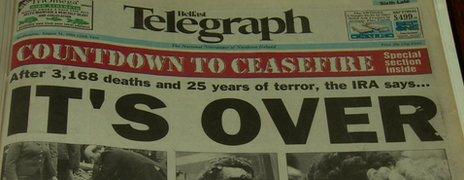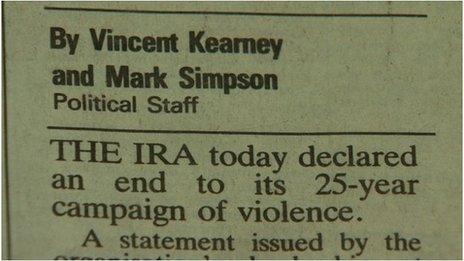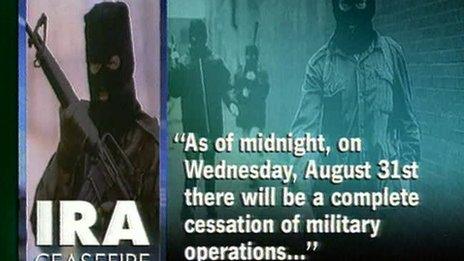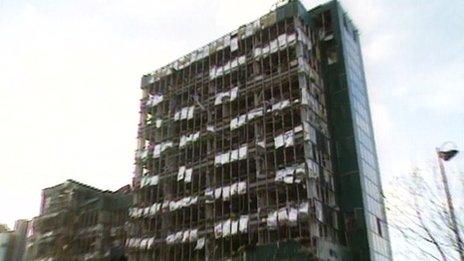'It's Over': Reporting the IRA ceasefire 20 years ago
- Published

The Belfast Telegraph headline on the day of the IRA ceasefire in 1994
The statement was written in neat, small handwriting on a tiny sheet of paper.
I had been met by a republican source and driven to a house in west Belfast where a man told me to write down what he read, and instructed me there would be no follow-up questions.
Afterwards, I was driven back to the place where I had been met and quickly made my way back to the Belfast Telegraph, where I was working as political correspondent at the time.
After briefing the editor, Ed Curran, about what was going to be announced in a few hours time, I started to write up the story that was going to break at 11:00 BST that morning, 31 August, 1994.
The huge presses that printed the newspaper rolled into action at 10:30 BST each morning, but not that day.
The ceasefire announcement was under embargo until 11:00 BST, so in an unprecedented step, a decision was taken to literally hold the presses until the moment the statement went public.

The story as told by Vincent Kearney and Mark Simpson
I was in the print hall just as the 11:00 BST radio news bulletins announced that the ceasefire had been declared and the order was given to roll the presses. A large red button was pressed and the huge machines kicked into action.
The Telegraph had gone with a dramatic front-page headline stating: "It's Over" with large photographs from three of the many incidents of the Troubles.
'Historic Event'
I watched as thousands of copies rolled off the presses, were sorted into bundles and rushed to a fleet of vans parked at the back door with their doors open.
The papers were quickly loaded and driven to news-stands and shops where they were quickly snapped up by a public eager to read the details of what truly was an historic event.
However, while the manner of the announcement was dramatic, it was not a surprise.
There had been speculation for months beforehand that the IRA was moving towards a ceasefire. Indeed, just two days earlier, I had reported that senior IRA members were believed to have been putting the final touches to the statement.
The announcement came about after very public contacts involving Sinn Féin and the British, Irish and American governments.
But it is generally accepted that the foundations were laid at Clonard Monastery in west Belfast, and the origins of the process that led to the ceasefire can be traced back to 1986.
In September that year, a meeting took place in secrecy behind closed doors at Clonard. It brought together two bitter political rivals, Sinn Féin president Gerry Adams and the leader of the SDLP, John Hume.
The meeting was arranged by a man they codenamed the Sagart, the Irish word for priest. His name was Father Alec Reid.
He died in November last year, but in a BBC documentary he spoke about his motivation.

The statement as it appeared on BBC NI's Newsline
"The thing first of all, was to persuade John Hume if he were prepared to talk to Gerry Adams he would enable Gerry Adams then to talk to the IRA in a way that could at least persuade them to stop," he said.
"I used to say I represent the next person who's going to be killed in this struggle. That was the line I took, that I don't belong to any political party, the only interest I have in this thing is the interest of the next victim."
As the secret talks continued for a number of years, so too did the killings.
Eight months after the first Clonard meeting, in May 1987, the SAS shot dead eight IRA men as they prepared to attack a police station in Loughgall, County Armagh. A civilian was also killed.
Crucial role
Six months later, 11 people were killed when the IRA bombed a Remembrance Sunday event in Enniskillen.
In the midst of the violence, no-one paid much attention when Peter Brooke was appointed secretary of state in July 1989. He was the latest in a long line to hold the office, but he was to play a crucial role.
Just over a year after his appointment, he made a speech in London in which he said Britain had no "strategic or economic interest" in Northern Ireland.
He had been advised to do so by John Hume, after being briefed about his secret talks with Gerry Adams.
"He said; 'There's no point in my talking to Mr Adams, it has to come from the lips of a British minister,' and I absorbed that," Mr Brooke told the BBC.
"But there was another factor beyond the need to say it in terms of overall policy and that was that I regularly read what I believed to be Mr Adams' column in An Phoblacht in which he implied pretty continuously that we were a colonial power which did actually have the kind of ambitions which I was denying and again I said to myself, it's just possible Mr Adams believes this and the last thing I should be doing is in any way augmenting his belief."
Unknown to him, Sinn Féin had been given advance notice of what he was going to say through a secret back channel between the British government and the IRA.
Reporting the 1994 IRA ceasefire
Martin McGuinness was the republican representative, while the government contact was a senior MI6 intelligence officer called Michael Oatley, codenamed the Mountain Climber.
Peter Brooke says he found out about the back channel early in 1991 when he was told Michael Oatley was retiring - and authorised M15 to continue the secret communications.
"No secretary of state should ever go to Northern Ireland, or at least I'm talking about the period to which I belonged, should go to Northern Ireland believing that the problem is going to be solved in his lifetime, I mean during his time in the province," he said.
"But every secretary of state should go aware, rather as in rugby football, that if an opportunity comes and an opening occurs, then you should respond to it."
The IRA's actions gave no hint that it was considering an end to its violence.
In February 1991 it carried out one of the most audacious attacks of the Troubles when it fired three mortars at Downing Street as prime minister John Major and his cabinet held an emergency meeting to discuss the Gulf War. One of the mortars exploded in the garden of Number 10.
Even the year before the ceasefire announcement, there was no hint that it was on the horizon.
In March 1993 the IRA bombed Warrington, killing 12-year-old Timothy Parry and three-year-old Jonathan Ball, and injuring 50 others.
It's Over: The IRA ceasefire 1994
In October that year, it killed nine Protestant civilians when it bombed a fish shop on the Shankill Road. One of the bombers also died.
A week later, loyalist gunmen retaliated when they walked into a pub in the village of Greysteel and shot dead six Catholics and a Protestant.
But a year that ended in escalating bloodshed had also seen intensified efforts to bring the violence to an end.
In the summer of 1993, Taoiseach Albert Reynolds brought together Gerry Adams and John Hume with his government and influential Irish Americans.
He believed this coalition, referred to by unionists as "the pan-nationalist front", would strengthen his hand in negotiations with the British government.
In December that year, Albert Reynolds and Prime Minister John Major published the Downing Street Declaration, external, which they said provided the foundation for a lasting political settlement.
"There is an opportunity to end violence for good in Northern Ireland," Mr Major said at the time.
"We believe that it's now up to those who have used or supported violence to take that opportunity. The door is open to them."
After months of discussions, the IRA leadership responded with the ceasefire announcement.
Republicans insist that the secret talks initiated by Fr Alec Reid in west Belfast eight years earlier were the catalyst.
"People make a mistake if they think that the engagement that took place between ourselves and the British government back channel, for want of a better word, was the motivating factor in bringing about the IRA ceasefire of 1994, that's not the way the process worked," Sinn Féin's Martin McGuinness said.
"What brought about the IRA ceasefire was the coming together of Irish America, support from the White House, the Albert Reynolds input and, of course, the initiative led by Gerry Adams and by John Hume, with the support of Father Alec Reid."
Mr McGuinness also rejected any suggestion that the IRA was forced into the move in order to avoid outright defeat.
Victory
"I have no doubt whatsoever that if we had not embarked on that initiative to get the ceasefire in 1994, the IRA would still be fighting to this very day, I have no doubt about it in my mind whatsoever," he said.
Sinn Féin portrayed the ceasefire as a victory and many republicans took to the streets, waving Irish Tricolours, and a cavalcade of cars drove up and down the Falls Road in west Belfast.
But not all republicans agreed.
They included Billy McKee, one of the founding members of the Provisional IRA and a former member of its ruling Army Council.
"It was a complete sell-out," he told the BBC.

The ceasefire ended when a huge IRA bomb exploded in Canary Wharf, London, in February 1996
"A lot of the people that were flying flags at that time and cheering on, if it was tomorrow there wouldn't be the same people. The people believed it was, 'we won the war', they were led actually to believe that."
But, in spite of the newspaper headline that day, the violence was not over.
The 1994 ceasefire did not hold, breaking down over demands that the IRA should prove that its cessation of violence was permanent by decommissioning its weapons.
It ended when a huge IRA bomb exploded in Canary Wharf, London, in February 1996.
Although it would be a further 18 months, in July 1997, before another, permanent ceasefire, was declared, the dramatic announcement 20 years ago was the beginning of the end.
- Published22 November 2013
